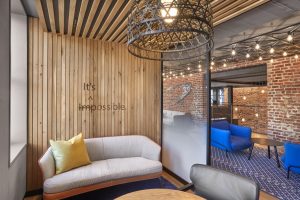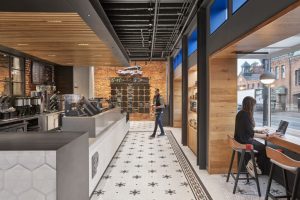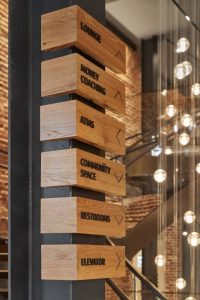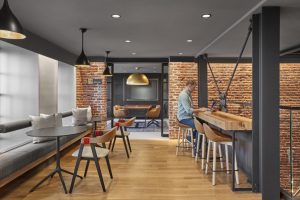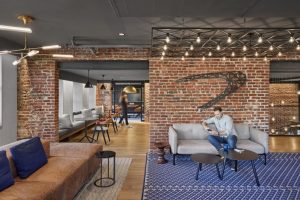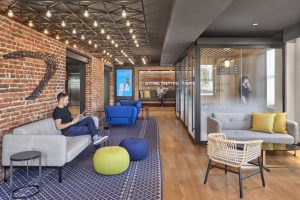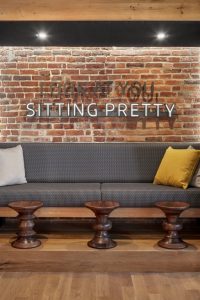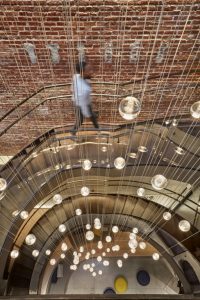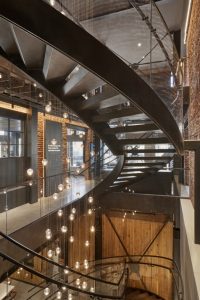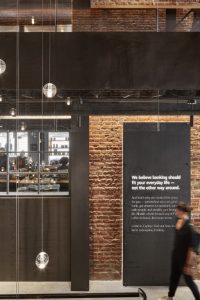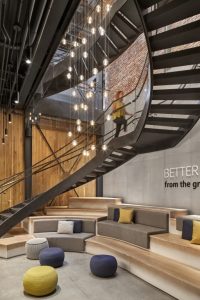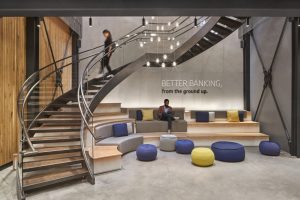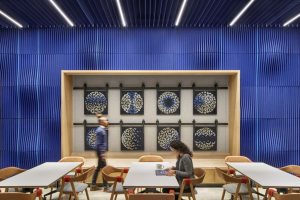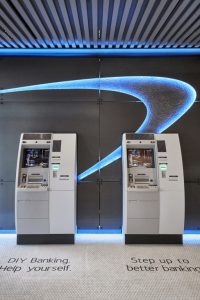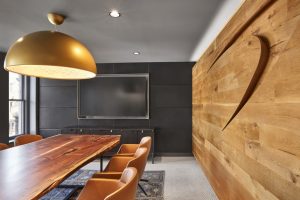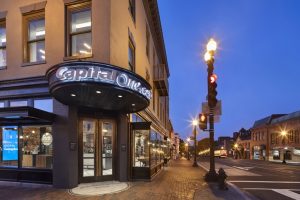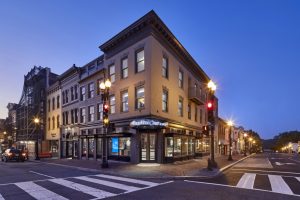Imagine a world where you can swing by the ATM, grab a coffee, attend a meeting or lecture and browse an art exhibit all in one stop. Thanks to the innovation of Capital One (McLean, Va.) and design firm CallisonRTKL (Baltimore), this haven of comfort and efficiency is a reality.
Who, What, Where, Why?
A blend of modern industrial and historic charm, the new Capital One Café flagship is located in the backyard of the bank’s headquarters in Georgetown, Washington, D.C.
After extensive research and workshopping, the team decided that the target demographic was affluent, young professionals, from 25 to 34 years old. Designers found that within three miles of the flagship there is $3.95 billion of disposable income with 43 percent earning at least a six-figure income. This became a “strategic beacon” for the project, what they needed to focus design on to attract the rest.
Something Old, Something New
Converting a historic building into a modern, functioning branch while maintaining the integrity of the original is no simple task. CallisonRTKL Senior Associate Vice President Jeany Kim says that this transformation was one of the biggest challenges. “It was a grueling, long process for us to get approval from the Old Georgetown Board,” she says. “We had no idea how hard it was going to be to get approval because they were very concerned about such a big corporation coming into their neighborhood. However, we made sure to preserve the historic building as much as possible and Capital One as a brand made sure that this café will have a connection to the local community.”
The struggles didn’t end upon approval, though. The café was actually created by the merging of two adjacent buildings, and preservation of original features was essential to this project. Kim notes the strategic design approach behind opening the walls between the two separate buildings as well as the balance between retaining the original brick wall and creating a flow between the spaces, “so that it doesn’t feel like two oddballs coming together,” she says.
In order to ensure both spaces looked visually cohesive, designers chose furniture and finishes that would best create a “harmonious blend.” For example, they opted for industrial blackened steel to better complement the brick. The furniture itself is kept neutral, with brand color accents used subtly throughout – a pop of blue in the window trim or red on the detail of a chair.
Advertisement
Capitalizing on Community
The café’s materials and lighting were sourced almost entirely locally and extensive research was put into choosing each manufacturer to ensure the project would support local small businesses. This would also show the local historic preservation board that while Capital One is a large corporation, its presence in the neighborhood would be beneficial.
Community involvement doesn’t end with design and construction: the Capital One Café offers co-working and flex spaces throughout the three floors of the building which are available for use for lectures, seminars or classes. A community arts program also makes its home in the café, with an art gallery open to the public.
Experiencing the Experiential
Retail trends are pointing in the direction of the creation of immersive and interactive environments for customers. Many retailers are expanding upon their traditional markets in order to engage customers in their communities by offering localized products (see Market by Macy’s) and incorporating food and drink into the shopping (or banking) experience.
Kim recognizes this burgeoning trend: “I think one of the biggest trends we’re seeing lately is the blurring of sectors. A bank is no longer just a bank, and retail is much more than just a place for sales. We’re giving the customer a more immersive experience – adding a layer of hospitality. Every business is trying to be more than just what their name is. Everything is combining into one.”
PROJECT SUPPLIERS
Retailer
Capital One, McLean, Va.
Advertisement
Design, Lighting, Signage/Graphics
CallisonRTKL, Baltimore: Jeany Kim, Senior Associate VP
Signage/Graphics, Props and Decoratives
Duggal, New York
Architecture
Leo A Daly, Washington, D.C.
General Contractor
Buch Construction Inc., Laurel, Md.
Audio/Visual, In-Store Tech
D&P, Lorton, Va.
In-Store Technology
Convergint Technologies, Illinois
Capital One, McLean, Va.
Advertisement
Ceilings, Fixtures
KRG, Philadelphia
Flooring
Pro Floors LLC, Atlanta, Ga.
Eloi Araujo
BelTile, Washington, D.C.
Materials/Wallcoverings
Designtex, Washington, D.C.
Maharam, Washington, D.C.
Waterworks, Georgetown, Washington, D.C.
Filzfelt, Washington, D.C.
Photography: Garrett Rowland/Courtesy of CallisonRTKL, San Francisco
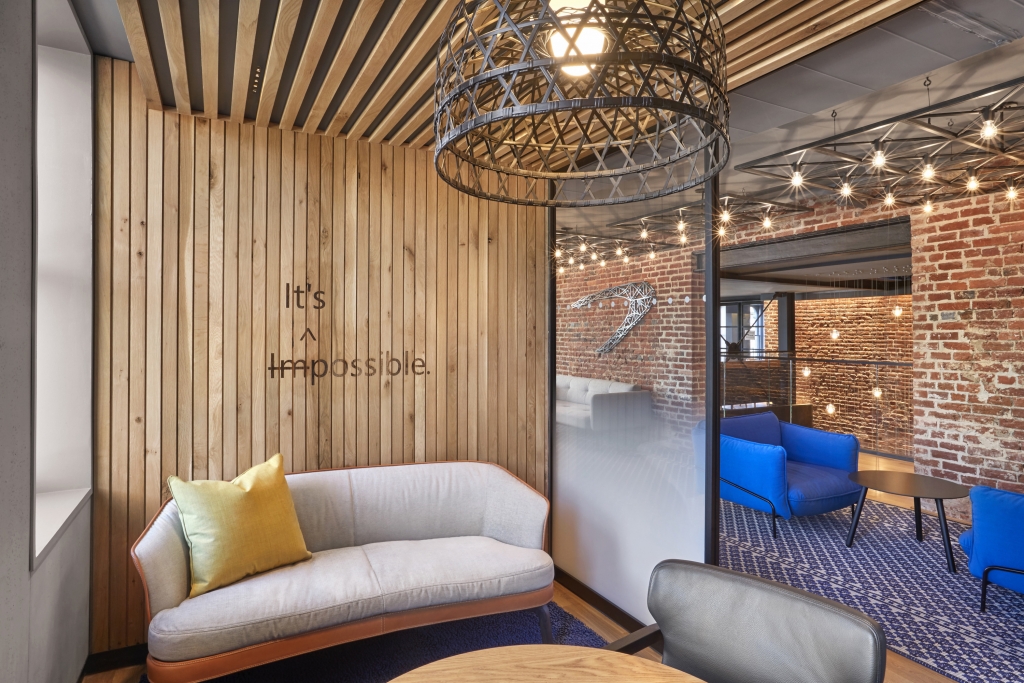

 Photo Gallery1 week ago
Photo Gallery1 week ago
 Headlines3 days ago
Headlines3 days ago
 Headlines1 week ago
Headlines1 week ago
 Headlines1 week ago
Headlines1 week ago
 Designer Dozen2 weeks ago
Designer Dozen2 weeks ago
 Headlines1 week ago
Headlines1 week ago
 Designer Dozen6 days ago
Designer Dozen6 days ago
 Headlines1 week ago
Headlines1 week ago
